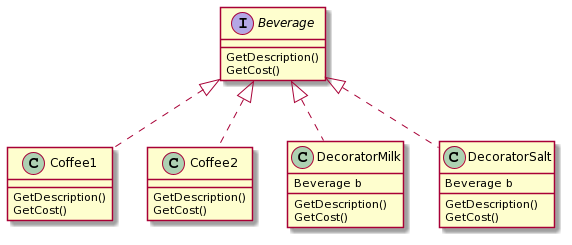- 一周掌握Flutter开发--10. 结构与设计模式
江上清风山间明月
Flutterflutter设计模式快速
文章目录10.项目结构与设计模式核心原则10.1分层架构10.1.1UI层10.1.2业务逻辑层10.1.3数据层10.2代码规范:遵循EffectiveDart10.2.1命名规范10.2.2代码格式10.2.3注释与文档10.3模块化设计10.3.1按功能拆分模块10.3.2模块化设计的优势10.3.3实现模块化总结10.项目结构与设计模式在Flutter开发中,良好的项目结构和设计模式是确保
- Android网络层架构:统一错误处理的问题分析到解决方案与设计实现
wzj_what_why_how
Android#Android——架构和设计android架构
前言在Android项目开发中,我们经常遇到需要统一处理某些特定状态码的场景。本文分享一个项目中遇到的4406状态码(实名认证)处理不统一问题,从问题分析到完整解决方案,提供一套可复用的架构设计模式。目录前言问题分析不同框架的回调处理机制解决方案关键技术细节添加应用拦截器循环依赖问题与回调接口模式问题分析解决方案:回调接口模式ResponseBody流管理问题现象原因总结源码分析总结其设计原理重复
- 【Java源码阅读系列44】深度解读Java NIO ByteBuffer 源码
·云扬·
源码阅读系列之Javajavanio开发语言
JavaNIO(NewInput/Output)中的ByteBuffer是Buffer抽象类的具体子类,专门用于处理字节数据的高效读写。作为NIO的核心组件,ByteBuffer支持堆内存(Heap)和直接内存(Direct)两种存储方式,广泛应用于网络通信、文件IO等场景。本文将结合源码,深入解析ByteBuffer的核心机制、关键方法及设计模式的应用。一、ByteBuffer的核心特性与存储方
- 一个实例用全创建型模式-优化(冗余消除)
科学的发展-只不过是读大自然写的代码
#c++ubuntu开发java算法前端
1.关联链接上一篇:一个实例用全创建型模式-CSDN博客目录:《一个实例讲完23种设计模式》2.内容当前:单件+抽象工厂+创建者+工厂方法+优化需求:坦克大战创建两种坦克坦克类型射程速度b7070米时/70公里b5050米时/50公里设计说明1.抽象工厂承担了创建部件的任务2.创建者承担了将部件组装的任务3.工厂方法类相当于创建者模式的导演,但是他是并未给用户提供选择创建者的接口。而是通过自己的多
- Python 领域 pytest 的测试用例的可维护性设计
Python领域pytest的测试用例的可维护性设计关键词:pytest、测试用例、可维护性、测试框架、自动化测试、测试设计模式、重构摘要:本文深入探讨了如何在Python测试框架pytest中设计可维护的测试用例。我们将从测试用例可维护性的核心原则出发,分析pytest的特性和最佳实践,介绍多种提高测试代码可维护性的设计模式和技巧。文章包含实际代码示例、项目实战案例以及可维护性评估指标,帮助开发
- FastAPI依赖注入:构建高可维护API的核心理念与实战
源滚滚AI编程
fastapilog4j
依赖注入(DependencyInjection,DI)作为FastAPI的核心设计模式,通过解耦组件依赖关系、提升代码复用性和可测试性,已成为现代API开发的基石。本文将深入解析其工作原理、高级特性及企业级应用场景。一、依赖注入的核心价值解耦与模块化将数据库连接、认证逻辑等基础设施与业务逻辑分离,避免代码冗余。示例:路由函数无需手动创建数据库连接,通过Depends(get_db)自动注入[ci
- React源码2 React中的工厂函数:createRoot()
gzzeason
ReactV18.2源码react.jsjavascript前端
#ReactV18.2源码前置基础知识:工厂函数工厂函数是一种设计模式,用于动态创建对象或函数实例。其核心思想是通过封装对象创建的细节,提供统一的接口,从而增强代码的灵活性和可维护性,有一些核心作用:解耦创建逻辑:将对象的实例化过程与使用分离,调用方无需关心具体实现细节。动态生成:根据输入参数返回不同类型的对象或函数。统一接口:通过单一入口点管理多种创建场景。工厂函数由构造函数进阶而来,都是用来创
- 基于多设计模式的同步&异步日志系统--代码设计(六)
久念祈
日志系统设计模式
目录日志器管理模块(单例)设计思想成员属性提供的接口代码实现:全局的日志器建造者代码实现全局接口的设计获取日志器的全局接口使用宏函数代理日志器的输出接口日志器管理模块(单例)用户可能会创建多个日志器,然后从中选取一个输出日志,那我们就需要将这些日志器管理起来,因此我们需要设计一个日志器管理模块。设计思想以日志器的名称作为唯一关键字将创建的日志器保存起来,允许用户通过日志器名称获取对应日志器,如果日
- 基于java实现责任链进行参数校验
吴free
责任链模式设计模式
责任链是什么在Java中,责任链模式(ChainofResponsibilityPattern)是一种行为设计模式,它允许对象以链式的方式组织起来,以便请求可以在链中传递,直到被某个对象处理为止。这种模式为多个对象处理同一请求提供了灵活的机制,并且可以将请求的处理者与请求的发送者解耦。责任链优点降低耦合度:该模式将请求的发送者和多个请求处理者解耦,发送者只需要将请求发送到链上,而不需要知道具体是哪
- 【设计模式】基于责任链模式的参数校验
沉着的码农
Java分布式Springjava分布式springboot
基于责任链模式的参数校验介绍接口定义根实现类具体校验器的实现用户校验器商品校验器预定校验器库存校验器责任链的编排使用介绍责任链模式(ChainofResponsibilityPattern)是一种行为设计模式,可以通过将一系列处理器按顺序链接起来,使得每个处理器都有机会处理请求,从而实现请求的传递和处理。此处我们用一个创建订单的例子在创建订单前进行各种的前置校验接口定义publicinterfac
- 设计模式 | 状态模式
@hdd
设计模式设计模式状态模式
状态模式(StatePattern)是行为型设计模式中的状态管理大师,它允许对象在其内部状态改变时改变其行为,使对象看起来像是修改了它的类。这种模式将状态抽象为独立的类,并通过委托将行为转移给当前状态对象,实现了状态与行为的优雅解耦。本文将深入探索状态模式的核心思想、实现技巧以及在C++中的高效实践。为什么需要状态模式?在软件开发中,对象行为常随状态变化:电梯的运行状态(停止、上升、下降)TCP连
- 软件建模、设计模式、重构
kingzdm
java设计模式设计模式重构uml
软件建模、设计模式、重构软件建模软件建模体现了软件设计的思想,在需求和实现之间架起了一座桥梁,通过模型指导软件系统的具体实现。模型并不是软件系统的一个完备表示,而是所研究的系统的一种抽象。软件建模通过不同的视角去描述一个系统。软件建模视角:外部视角,交互视角,结构化视角,行为视角。软件建模方法:结构化方法,面向对象方法,基于构建方法,面向服务方法,面向方面方法,模型驱动方法,形式化方法。UML特点
- (4)设计模式-重构
偶像来了
设计模式单元测试java设计模式编程语言
文章目录1.为什么要重构(why)2.重构什么(what)3.什么时候重构(when)4.如何重构(how)5.保证重构不出错,落地的技术手段--单元测试5.1什么是单元测试5.2为什么要写单元测试6.可测试性代码6.1代码的可测试性6.2编写可测试性代码的最有效手段6.3常见的测试性不好的代码7.解耦7.1解耦为何很重要7.2代码是否需要解耦7.3如何给代码解耦1.为什么要重构(why)重构是一
- C++游戏开发的一些高级常识(持续更新)
Silver Gamer
迈向游戏引擎工程师C++
C++游戏开发高级常识(纲领整理)前言序章C++开发细节基础1.C++类型转换2.C++静态相关3.C++函数指针4.C++函数指针返回值5.C++常量6.C++开发常用设计模式7.常用STL8.C++面向对象理解9.C++构造与析构10.虚拟内存与物理内存11.C++多态实现原理12.操作系统运行程序流程13.智能指针及其实现14.malloc和alloc的关联与详细过程15.C++内存模型16
- 设计模式---代理模式
1.简介代理模式(ProxyPattern)是一种结构型设计模式,它能够为其他对象提供一个代理以控制对这个对象的访问。代理模式在不直接访问实际对象的情况下,提供了对目标对象的间接访问。通过引入一个代理对象来间接操作实际对象,可以在不改变实际对象代码的前提下,增加额外的功能操作,如访问控制、延迟初始化、日志记录、事务管理等。代理模式通常分为几种类型:静态代理:在代码编译时就已经确定代理类和目标类的关
- Java结构型模式---适配器模式
适配器模式基础概念适配器模式是一种结构型设计模式,其核心思想是将一个类的接口转换成客户希望的另一个接口。适配器模式使得原本由于接口不兼容而不能一起工作的那些类可以一起工作。适配器模式就像一个"转换器",将两个不兼容的接口进行适配。适配器模式的核心组件目标接口(Target)-客户端所期望的接口适配者类(Adaptee)-现有的、需要被适配的类适配器类(Adapter)-连接目标接口和适配者类的桥梁
- Java创建型模式---建造者模式
建造者模式基础概念建造者模式是一种创建型设计模式,其核心思想是将一个复杂对象的构建与表示分离,使得同样的构建过程可以创建不同的表示。建造者模式允许你分步构建一个复杂对象,通过相同的构建步骤可以得到不同的表示形式。建造者模式的核心组件产品类(Product)-要构建的复杂对象抽象建造者(Builder)-定义构建产品各个部分的抽象接口具体建造者(ConcreteBuilder)-实现抽象建造者接口,
- Java结构型模式---代理模式
代理模式基础概念代理模式是一种结构型设计模式,其核心思想是通过创建一个代理对象来控制对另一个真实对象的访问。代理对象在客户端和真实对象之间起到中介作用,允许在不改变真实对象的前提下,对其进行增强或控制。代理模式的核心组件主题接口(Subject)-定义真实对象和代理对象的共同接口,客户端通过该接口访问真实对象真实主题(RealSubject)-实现主题接口,是实际要被代理的对象代理(Proxy)-
- 空对象模式(Null Object Pattern)
froginwe11
开发语言
空对象模式(NullObjectPattern)在面向对象编程中,空对象模式(NullObjectPattern)是一种设计模式,其核心思想是当对象不包含任何有意义的行为或状态时,提供一个空对象来代替一个实际的对象。这样可以在不创建实际对象的情况下,避免空指针异常,提高代码的健壮性和可读性。一、空对象模式概述空对象模式通过引入一个空对象来替代空指针,使得程序在处理对象引用时更加安全。这种模式在以下
- 设计模式-享元模式
一、用到的类一个接口一个接口实现类一个享元工厂:里面有一个用于存储实现类的map,key为我们随机指定的(我们自己是知道的,以后会用这个key去获取),还有一个获取对象方法,先去map中找,找不到就创建并塞入map,找到了就返回二、实现代码接口代码publicinterfaceShape{voiddraw();}接口实现代码publicclassCircleimplementsShape{priv
- 基于odoo17的设计模式详解---备忘模式
花好月圆春祺夏安
设计模式数据库
大家好,我是你的Odoo技术伙伴。在开发复杂的业务流程时,我们有时会遇到这样的需求:在对一个对象进行一系列复杂操作之前,保存其当前状态,以便在操作失败或用户希望撤销时,能够一键恢复到操作之前的样子。或者,我们需要追踪一个对象(如一份合同)在不同时间点的所有历史版本。实现这种“状态快照”和“时光倒流”功能的背后,正是我们今天要探讨的设计模式——备忘录模式(MementoPattern)。一、什么是备
- 基于odoo17的设计模式详解---工厂模式
大家好,我是你的Odoo技术伙伴。在Odoo开发中,我们几乎每天都在创建各种对象:新的客户记录、销售订单、发票、库存移动等等。虽然表面上我们只是简单地调用self.env['some.model'].create(...),但在这看似简单的操作背后,Odoo的ORM扮演着一个极其强大和复杂的工厂(Factory)角色。今天,我们将深入探讨经典的工厂模式(FactoryPattern),并揭示Odo
- 基于odoo17的设计模式详解---适配模式
花好月圆春祺夏安
设计模式
大家好,我是你的Odoo技术伙伴。在一个现代化的企业信息系统中,Odoo往往不是一座孤岛。它需要与各种各样的外部系统进行数据交换:可能是老旧的ERP系统、第三方的物流API、不同格式的支付网关,或者是需要导入的CSV/Excel文件。这些外部系统的数据格式和接口,几乎不可能与Odoo原生的模型和API完全兼容。这时,我们就需要一个“翻译官”或“转换插头”来连接这两个不同的世界。这个角色,正是由我们
- 基于odoo17的设计模式详解---中介模式
花好月圆春祺夏安
设计模式
大家好,我是你的Odoo技术伙伴。在复杂的业务场景中,对象之间的交互往往会变得错综复杂,形成一张难以维护的“蜘蛛网”式的依赖关系。每个对象都需要了解许多其他对象,任何一个小小的改动都可能引发连锁反应。为了解决这个问题,软件设计领域引入了中介者模式(MediatorPattern)。今天,我们将深入探讨这一模式,并揭示Odoo17是如何在不显式声明“Mediator”类的情况下,将其中介思想融入其核
- 基于odoo17的设计模式详解---外观模式
大家好,我是你的Odoo技术伙伴。在构建复杂的企业级应用时,我们常常会遇到一个棘手的问题:一个单一的业务操作,比如“确认一张销售订单”,背后可能需要与库存、财务、采购、项目等多个子系统进行复杂的交互。如果让调用者(比如一个按钮的点击事件)直接去协调所有这些子系统,代码将会变得极其混乱和脆弱。为了解决这个问题,软件工程领域引入了外观模式(FacadePattern)。今天,我们就来深入探讨这一模式,
- 基于odoo17的设计模式详解---迭代模式
花好月圆春祺夏安
设计模式
大家好,我是你的Odoo技术伙伴。在Odoo开发中,最常见的操作之一莫过于处理一组数据记录。我们使用search()方法获取一批客户,访问销售订单的所有订单行,或者对选中的多张发票进行批量操作。这背后,都离不开一个基础而又强大的设计模式——迭代器模式(IteratorPattern)。今天,我们将深入探讨这个“润物细无声”的设计模式,看看Odoo是如何将其无缝集成到ORM的记录集(Recordse
- C# 项目
卷纸要用清风的
C#c#开发语言
语言基础开发环境与工具框架与库数据库与数据存储项目架构与设计模式前端技术(全栈开发场景)版本控制与协作测试与质量保障部署与运维安全实战项目建议学习资源推荐总结语言基础C#语法:变量、数据类型、控制流(条件语句、循环)、运算符、异常处理(try-catch)等。面向对象编程(OOP):类与对象、继承、多态、封装、接口、抽象类。高级特性:委托(Delegate)与事件(Event)LINQ(Langu
- C# 设计模式——单例模式(Singleton Pattern)
Pdtian
C#设计模式c#设计模式单例模式
单例模式(SingletonPattern)是设计模式中最基础但应用最广泛的一种模式,它确保一个类只有一个实例,并提供一个全局访问点。在C#开发中,单例模式常用于管理共享资源、配置管理、日志系统等场景。文章目录一、基础实现:线程不安全的单例二、线程安全实现1.双重检查锁定模式(Double-CheckLocking)2.使用Lazy(推荐方式)三、进阶实现技巧1.防止反射攻击2.处理序列化问题四、
- 设计模式之访问者模式
缘来是庄
设计模式设计模式访问者模式java
目录定义结构适用场景使用示例定义访问者模式(VisitorPattern)是一种行为型设计模式,其核心思想是将数据结构与数据操作解耦,允许在不修改现有对象结构的前提下定义作用于对象元素的新操作。访问者模式有以下核心要点:1)数据结构稳定,被访问的对象结构(元素类)相对固定,不频繁变动。2)操作可扩展,新增操作只需添加新的访问者类,无需修改元素类代码,符合开闭原则。3)双分派机制,通过ac
- C++软件设计模式之迭代器模式
捕鲸叉
软件设计模式C++设计模式c++迭代器模式
迭代器模式是一种行为设计模式,它允许你顺序访问一个聚合对象的元素,而不暴露其底层表示。在C++软件设计中,迭代器模式的主要目的是将数据的遍历行为与数据结构本身分离,使得数据结构的修改不会影响到遍历代码。目的和意图解耦遍历与数据结构:迭代器模式使得遍历算法独立于数据结构的实现。这意味着你可以改变数据结构的内部表示,而不需要修改遍历代码。提供统一的访问接口:无论底层数据结构如何,迭代器都提供了一套统一
- jsonp 常用util方法
hw1287789687
jsonpjsonp常用方法jsonp callback
jsonp 常用java方法
(1)以jsonp的形式返回:函数名(json字符串)
/***
* 用于jsonp调用
* @param map : 用于构造json数据
* @param callback : 回调的javascript方法名
* @param filters : <code>SimpleBeanPropertyFilter theFilt
- 多线程场景
alafqq
多线程
0
能不能简单描述一下你在java web开发中需要用到多线程编程的场景?0
对多线程有些了解,但是不太清楚具体的应用场景,能简单说一下你遇到的多线程编程的场景吗?
Java多线程
2012年11月23日 15:41 Young9007 Young9007
4
0 0 4
Comment添加评论关注(2)
3个答案 按时间排序 按投票排序
0
0
最典型的如:
1、
- Maven学习——修改Maven的本地仓库路径
Kai_Ge
maven
安装Maven后我们会在用户目录下发现.m2 文件夹。默认情况下,该文件夹下放置了Maven本地仓库.m2/repository。所有的Maven构件(artifact)都被存储到该仓库中,以方便重用。但是windows用户的操作系统都安装在C盘,把Maven仓库放到C盘是很危险的,为此我们需要修改Maven的本地仓库路径。
- placeholder的浏览器兼容
120153216
placeholder
【前言】
自从html5引入placeholder后,问题就来了,
不支持html5的浏览器也先有这样的效果,
各种兼容,之前考虑,今天测试人员逮住不放,
想了个解决办法,看样子还行,记录一下。
【原理】
不使用placeholder,而是模拟placeholder的效果,
大概就是用focus和focusout效果。
【代码】
<scrip
- debian_用iso文件创建本地apt源
2002wmj
Debian
1.将N个debian-506-amd64-DVD-N.iso存放于本地或其他媒介内,本例是放在本机/iso/目录下
2.创建N个挂载点目录
如下:
debian:~#mkdir –r /media/dvd1
debian:~#mkdir –r /media/dvd2
debian:~#mkdir –r /media/dvd3
….
debian:~#mkdir –r /media
- SQLSERVER耗时最长的SQL
357029540
SQL Server
对于DBA来说,经常要知道存储过程的某些信息:
1. 执行了多少次
2. 执行的执行计划如何
3. 执行的平均读写如何
4. 执行平均需要多少时间
列名 &
- com/genuitec/eclipse/j2eedt/core/J2EEProjectUtil
7454103
eclipse
今天eclipse突然报了com/genuitec/eclipse/j2eedt/core/J2EEProjectUtil 错误,并且工程文件打不开了,在网上找了一下资料,然后按照方法操作了一遍,好了,解决方法如下:
错误提示信息:
An error has occurred.See error log for more details.
Reason:
com/genuitec/
- 用正则删除文本中的html标签
adminjun
javahtml正则表达式去掉html标签
使用文本编辑器录入文章存入数据中的文本是HTML标签格式,由于业务需要对HTML标签进行去除只保留纯净的文本内容,于是乎Java实现自动过滤。
如下:
public static String Html2Text(String inputString) {
String htmlStr = inputString; // 含html标签的字符串
String textSt
- 嵌入式系统设计中常用总线和接口
aijuans
linux 基础
嵌入式系统设计中常用总线和接口
任何一个微处理器都要与一定数量的部件和外围设备连接,但如果将各部件和每一种外围设备都分别用一组线路与CPU直接连接,那么连线
- Java函数调用方式——按值传递
ayaoxinchao
java按值传递对象基础数据类型
Java使用按值传递的函数调用方式,这往往使我感到迷惑。因为在基础数据类型和对象的传递上,我就会纠结于到底是按值传递,还是按引用传递。其实经过学习,Java在任何地方,都一直发挥着按值传递的本色。
首先,让我们看一看基础数据类型是如何按值传递的。
public static void main(String[] args) {
int a = 2;
- ios音量线性下降
bewithme
ios音量
直接上代码吧
//second 几秒内下降为0
- (void)reduceVolume:(int)second {
KGVoicePlayer *player = [KGVoicePlayer defaultPlayer];
if (!_flag) {
_tempVolume = player.volume;
- 与其怨它不如爱它
bijian1013
选择理想职业规划
抱怨工作是年轻人的常态,但爱工作才是积极的心态,与其怨它不如爱它。
一般来说,在公司干了一两年后,不少年轻人容易产生怨言,除了具体的埋怨公司“扭门”,埋怨上司无能以外,也有许多人是因为根本不爱自已的那份工作,工作完全成了谋生的手段,跟自已的性格、专业、爱好都相差甚远。
- 一边时间不够用一边浪费时间
bingyingao
工作时间浪费
一方面感觉时间严重不够用,另一方面又在不停的浪费时间。
每一个周末,晚上熬夜看电影到凌晨一点,早上起不来一直睡到10点钟,10点钟起床,吃饭后玩手机到下午一点。
精神还是很差,下午像一直野鬼在城市里晃荡。
为何不尝试晚上10点钟就睡,早上7点就起,时间完全是一样的,把看电影的时间换到早上,精神好,气色好,一天好状态。
控制让自己周末早睡早起,你就成功了一半。
有多少个工作
- 【Scala八】Scala核心二:隐式转换
bit1129
scala
Implicits work like this: if you call a method on a Scala object, and the Scala compiler does not see a definition for that method in the class definition for that object, the compiler will try to con
- sudoku slover in Haskell (2)
bookjovi
haskellsudoku
继续精简haskell版的sudoku程序,稍微改了一下,这次用了8行,同时性能也提高了很多,对每个空格的所有解不是通过尝试算出来的,而是直接得出。
board = [0,3,4,1,7,0,5,0,0,
0,6,0,0,0,8,3,0,1,
7,0,0,3,0,0,0,0,6,
5,0,0,6,4,0,8,0,7,
- Java-Collections Framework学习与总结-HashSet和LinkedHashSet
BrokenDreams
linkedhashset
本篇总结一下两个常用的集合类HashSet和LinkedHashSet。
它们都实现了相同接口java.util.Set。Set表示一种元素无序且不可重复的集合;之前总结过的java.util.List表示一种元素可重复且有序
- 读《研磨设计模式》-代码笔记-备忘录模式-Memento
bylijinnan
java设计模式
声明: 本文只为方便我个人查阅和理解,详细的分析以及源代码请移步 原作者的博客http://chjavach.iteye.com/
import java.util.ArrayList;
import java.util.List;
/*
* 备忘录模式的功能是,在不破坏封装性的前提下,捕获一个对象的内部状态,并在对象之外保存这个状态,为以后的状态恢复作“备忘”
- 《RAW格式照片处理专业技法》笔记
cherishLC
PS
注意,这不是教程!仅记录楼主之前不太了解的
一、色彩(空间)管理
作者建议采用ProRGB(色域最广),但camera raw中设为ProRGB,而PS中则在ProRGB的基础上,将gamma值设为了1.8(更符合人眼)
注意:bridge、camera raw怎么设置显示、输出的颜色都是正确的(会读取文件内的颜色配置文件),但用PS输出jpg文件时,必须先用Edit->conv
- 使用 Git 下载 Spring 源码 编译 for Eclipse
crabdave
eclipse
使用 Git 下载 Spring 源码 编译 for Eclipse
1、安装gradle,下载 http://www.gradle.org/downloads
配置环境变量GRADLE_HOME,配置PATH %GRADLE_HOME%/bin,cmd,gradle -v
2、spring4 用jdk8 下载 https://jdk8.java.
- mysql连接拒绝问题
daizj
mysql登录权限
mysql中在其它机器连接mysql服务器时报错问题汇总
一、[running]
[email protected]:~$mysql -uroot -h 192.168.9.108 -p //带-p参数,在下一步进行密码输入
Enter password: //无字符串输入
ERROR 1045 (28000): Access
- Google Chrome 为何打压 H.264
dsjt
applehtml5chromeGoogle
Google 今天在 Chromium 官方博客宣布由于 H.264 编解码器并非开放标准,Chrome 将在几个月后正式停止对 H.264 视频解码的支持,全面采用开放的 WebM 和 Theora 格式。
Google 在博客上表示,自从 WebM 视频编解码器推出以后,在性能、厂商支持以及独立性方面已经取得了很大的进步,为了与 Chromium 现有支持的編解码器保持一致,Chrome
- yii 获取控制器名 和方法名
dcj3sjt126com
yiiframework
1. 获取控制器名
在控制器中获取控制器名: $name = $this->getId();
在视图中获取控制器名: $name = Yii::app()->controller->id;
2. 获取动作名
在控制器beforeAction()回调函数中获取动作名: $name =
- Android知识总结(二)
come_for_dream
android
明天要考试了,速速总结如下
1、Activity的启动模式
standard:每次调用Activity的时候都创建一个(可以有多个相同的实例,也允许多个相同Activity叠加。)
singleTop:可以有多个实例,但是不允许多个相同Activity叠加。即,如果Ac
- 高洛峰收徒第二期:寻找未来的“技术大牛” ——折腾一年,奖励20万元
gcq511120594
工作项目管理
高洛峰,兄弟连IT教育合伙人、猿代码创始人、PHP培训第一人、《细说PHP》作者、软件开发工程师、《IT峰播》主创人、PHP讲师的鼻祖!
首期现在的进程刚刚过半,徒弟们真的很棒,人品都没的说,团结互助,学习刻苦,工作认真积极,灵活上进。我几乎会把他们全部留下来,现在已有一多半安排了实际的工作,并取得了很好的成绩。等他们出徒之日,凭他们的能力一定能够拿到高薪,而且我还承诺过一个徒弟,当他拿到大学毕
- linux expect
heipark
expect
1. 创建、编辑文件go.sh
#!/usr/bin/expect
spawn sudo su admin
expect "*password*" { send "13456\r\n" }
interact
2. 设置权限
chmod u+x go.sh 3.
- Spring4.1新特性——静态资源处理增强
jinnianshilongnian
spring 4.1
目录
Spring4.1新特性——综述
Spring4.1新特性——Spring核心部分及其他
Spring4.1新特性——Spring缓存框架增强
Spring4.1新特性——异步调用和事件机制的异常处理
Spring4.1新特性——数据库集成测试脚本初始化
Spring4.1新特性——Spring MVC增强
Spring4.1新特性——页面自动化测试框架Spring MVC T
- idea ubuntuxia 乱码
liyonghui160com
1.首先需要在windows字体目录下或者其它地方找到simsun.ttf 这个 字体文件。
2.在ubuntu 下可以执行下面操作安装该字体:
sudo mkdir /usr/share/fonts/truetype/simsun
sudo cp simsun.ttf /usr/share/fonts/truetype/simsun
fc-cache -f -v
- 改良程序的11技巧
pda158
技巧
有很多理由都能说明为什么我们应该写出清晰、可读性好的程序。最重要的一点,程序你只写一次,但以后会无数次的阅读。当你第二天回头来看你的代码 时,你就要开始阅读它了。当你把代码拿给其他人看时,他必须阅读你的代码。因此,在编写时多花一点时间,你会在阅读它时节省大量的时间。
让我们看一些基本的编程技巧:
尽量保持方法简短
永远永远不要把同一个变量用于多个不同的
- 300个涵盖IT各方面的免费资源(下)——工作与学习篇
shoothao
创业免费资源学习课程远程工作
工作与生产效率:
A. 背景声音
Noisli:背景噪音与颜色生成器。
Noizio:环境声均衡器。
Defonic:世界上任何的声响都可混合成美丽的旋律。
Designers.mx:设计者为设计者所准备的播放列表。
Coffitivity:这里的声音就像咖啡馆里放的一样。
B. 避免注意力分散
Self Co
- 深入浅出RPC
uule
rpc
深入浅出RPC-浅出篇
深入浅出RPC-深入篇
RPC
Remote Procedure Call Protocol
远程过程调用协议
它是一种通过网络从远程计算机程序上请求服务,而不需要了解底层网络技术的协议。RPC协议假定某些传输协议的存在,如TCP或UDP,为通信程序之间携带信息数据。在OSI网络通信模型中,RPC跨越了传输层和应用层。RPC使得开发
